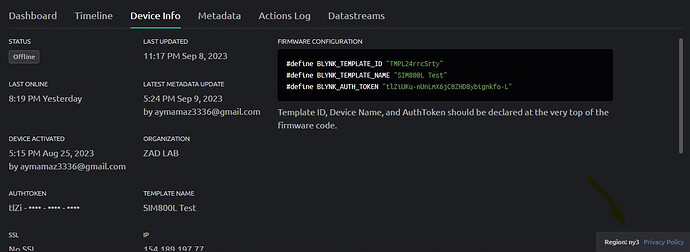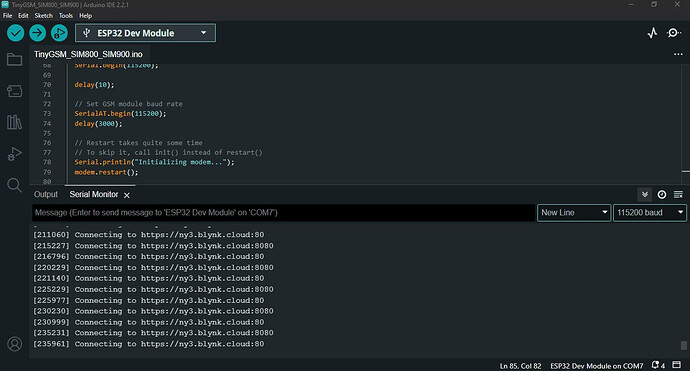Hi … i’m new in the community from EGYPT .
but i have a problem with blynk server connection
it was working fine for along days , and yesterday i finally purches a pro plan for a month after many sucssfull work with blink .
but after yesterday subscribtion i have a " Connecting to blynk.cloud:80 Login timeout " error
without any change with hardware (ESP32 Wroom + SIM800L ) .
And for this error i return to the basic examble code for TinyGSM_SIM800_SIM900
/*************************************************************
Blynk is a platform with iOS and Android apps to control
ESP32, Arduino, Raspberry Pi and the likes over the Internet.
You can easily build mobile and web interfaces for any
projects by simply dragging and dropping widgets.
Downloads, docs, tutorials: https://www.blynk.io
Sketch generator: https://examples.blynk.cc
Blynk community: https://community.blynk.cc
Follow us: https://www.fb.com/blynkapp
https://twitter.com/blynk_app
Blynk library is licensed under MIT license
This example code is in public domain.
*************************************************************
Attention! Please check out TinyGSM guide:
https://tiny.cc/tinygsm-readme
Change GPRS apm, user, pass, and Blynk auth token to run :)
Feel free to apply it to any other example. It's simple!
*************************************************************/
/* Comment this out to disable prints and save space */
#define BLYNK_DEBUG // Optional, this enables lots of prints
#define BLYNK_PRINT Serial
/* Fill in information from Blynk Device Info here */
#define BLYNK_TEMPLATE_ID "TMPL24rrcSrty"
#define BLYNK_TEMPLATE_NAME "SIM800L Test"
#define BLYNK_AUTH_TOKEN "tlZiUKu-nUnLmX6jC0ZHD8ybignkfo-L"
// Select your modem:
#define TINY_GSM_MODEM_SIM800
//#define TINY_GSM_MODEM_SIM900
//#define TINY_GSM_MODEM_M590
//#define TINY_GSM_MODEM_A6
//#define TINY_GSM_MODEM_A7
//#define TINY_GSM_MODEM_BG96
//#define TINY_GSM_MODEM_XBEE
// Default heartbeat interval for GSM is 60
// If you want override this value, uncomment and set this option:
//#define BLYNK_HEARTBEAT 10
#include <TinyGsmClient.h>
#include <BlynkSimpleTinyGSM.h>
// Your GPRS credentials
// Leave empty, if missing user or pass
char apn[] = "YourAPN";
char user[] = "";
char pass[] = "";
// Hardware Serial on Mega, Leonardo, Micro
#define SerialAT Serial2
// or Software Serial on Uno, Nano
//#include <SoftwareSerial.h>
//SoftwareSerial SerialAT(2, 3); // RX, TX
TinyGsm modem(SerialAT);
void setup()
{
// Debug console
Serial.begin(115200);
delay(10);
// Set GSM module baud rate
SerialAT.begin(115200);
delay(3000);
// Restart takes quite some time
// To skip it, call init() instead of restart()
Serial.println("Initializing modem...");
modem.restart();
// Unlock your SIM card with a PIN
//modem.simUnlock("1234");
Blynk.begin(BLYNK_AUTH_TOKEN, modem, apn, user, pass);
//Blynk.begin(auth, ssid, pass, "blynk-cloud.com",8080);
}
void loop()
{
Blynk.run();
}
my terminal output …
Initializing modem...
[7667]
___ __ __
/ _ )/ /_ _____ / /__
/ _ / / // / _ \/ '_/
/____/_/\_, /_//_/_/\_\
/___/ v1.3.0 on ESP32
#StandWithUkraine https://bit.ly/swua
[7677] Modem init...
[7709] Connecting to network...
[15122] Network: Orange EG
[15123] Connecting to YourAPN ...
[21286] Connected to GPRS
[21297] Connecting to blynk.cloud:80
[22100] <[1D|00|01|00|20]tlZiUKu-nUnLmX6jC0ZHD8ybignkfo-L
[28118] Login timeout
[28132] Connecting to blynk.cloud:80
[30597] <[1D|00|01|00|20]tlZiUKu-nUnLmX6jC0ZHD8ybignkfo-L
[36617] Login timeout
[36632] Connecting to blynk.cloud:80
[37460] <[1D|00|01|00|20]tlZiUKu-nUnLmX6jC0ZHD8ybignkfo-L
[42481] Connecting to blynk.cloud:80
[43076] <[1D|00|01|00|20]tlZiUKu-nUnLmX6jC0ZHD8ybignkfo-L
[49096] Login timeout
[49110] Connecting to blynk.cloud:80
[49477] <[1D|00|01|00|20]tlZiUKu-nUnLmX6jC0ZHD8ybignkfo-L
[55498] Login timeout
[55512] Connecting to blynk.cloud:80
[55917] <[1D|00|01|00|20]tlZiUKu-nUnLmX6jC0ZHD8ybignkfo-L
[60941] Connecting to blynk.cloud:80
[61820] <[1D|00|01|00|20]tlZiUKu-nUnLmX6jC0ZHD8ybignkfo-L
[67838] Login timeout
[67853] Connecting to blynk.cloud:80
I was working with 1.3.0 blynk library with arduino 2.2.1 IDE without any problem , but after ubove problem i upgraded the blynk library to 1.3.2 … but it not solve it .
pic from my blynk device dashboard
any help … ?
thanks 



